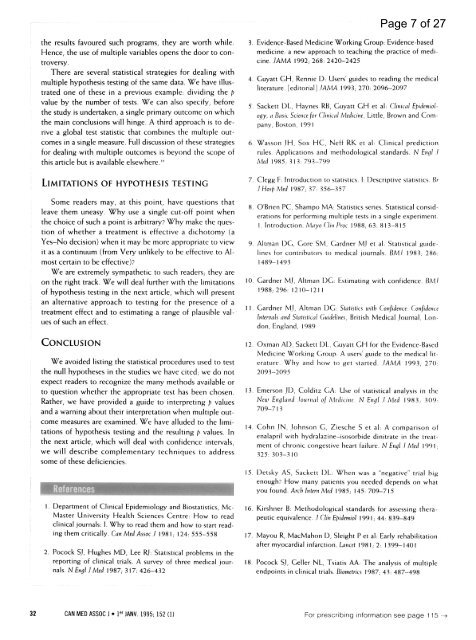CMAJ 1995 Basic Statistics for Clinicians
CMAJ 1995 Basic Statistics for Clinicians
CMAJ 1995 Basic Statistics for Clinicians
Create successful ePaper yourself
Turn your PDF publications into a flip-book with our unique Google optimized e-Paper software.
the results favoured such programs, they are worth while.<br />
Hence, the use of multiple variables opens the door to controversy.<br />
There are several statistical strategies <strong>for</strong> dealing with<br />
multiple hypothesis testing of the same data. We have illustrated<br />
one of these in a previous example: dividing the p<br />
value by the number of tests. We can also specify, be<strong>for</strong>e<br />
the study is undertaken, a single primary outcome on which<br />
the main conclusions will hinge. A third approach is to derive<br />
a global test statistic that combines the multiple outcomes<br />
in a single measure. Full discussion of these strategies<br />
<strong>for</strong> dealing with multiple outcomes is beyond the scope of<br />
this article but is available elsewhere.8<br />
LIMITATIONS OF HYPOTHESIS TESTING<br />
Some readers may, at this point, have questions that<br />
leave them uneasy. Why use a single cut-off point when<br />
the choice of such a point is arbitrary? Why make the question<br />
of whether a treatment is effective a dichotomy (a<br />
Yes-No decision) when it may be more appropriate to view<br />
it as a continuum (from Very unlikely to be effective to Almost<br />
certain to be effective)?<br />
We are extremely sympathetic to such readers; they are<br />
on the right track. We will deal further with the limitations<br />
of hypothesis testing in the next article, which will present<br />
an alternative approach to testing <strong>for</strong> the presence of a<br />
treatment effect and to estimating a range of plausible val-'<br />
ues of such an effect.<br />
CONCLUSION<br />
We avoided listing the statistical procedures used to test<br />
the null hypotheses in the studies we have cited; we do not<br />
expect readers to recognize the many methods available or<br />
to question whether the appropriate test has been chosen.<br />
Rather, we have provided a guide to interpreting p values<br />
and a warning about their interpretation when multiple outcome<br />
measures are examined. We have alluded to the limitations<br />
of hypothesis testing and the resulting p values. In<br />
the next article, which will deal with confidence intervals,<br />
we will describe complementary techniques to address<br />
some of these deficiencies.<br />
~~~~~~~~~~~~~~~~~.......<br />
~<br />
1. Department of Clinical Epidemiology and Biostatistics, Mc-<br />
Master University Health Sciences Centre: How to read<br />
clinical journals: 1. Why to read them and how to start reading<br />
them critically. Can Med Assoc J 198 1; 124: 555-558<br />
2. Pocock SJ, Hughes MD, Lee RJ: Statistical problems in the<br />
reporting of clinical trials. A survey of three medical journals.<br />
N Engl J Med 1987; 317: 426-432<br />
.............<br />
Page 7 of 27<br />
3. Evidence-Based Medicine Working Group: Evidence-based<br />
medicine: a new approach to teaching the practice of medicine.<br />
JAM-A 1992; 268: 2420-2425<br />
4. Guyatt GH, Rennie D: Users' guides to reading the medical<br />
literature. [editorial] JAMA 1993; 270: 2096-2097<br />
5. Sackett DL, Haynes RB, Guyatt GH et al: Clinical Epidemiology,<br />
a <strong>Basic</strong> Scienice<strong>for</strong> Clinical Medicine, Little, Brown and Company,<br />
Boston, 1991<br />
6. Wasson JH, Sox HC, Neff RK et al: Clinical prediction<br />
rules. Applications and methodological standards. N Eingl J<br />
Aled 1985; 313: 793-799<br />
7. Clegg F Introduction to statistics. 1: Descriptive statistics. Br<br />
1 Hosp Med 1987; 37: 356-357<br />
8. O'Brien PC, Shampo MA: <strong>Statistics</strong> series. Statistical considerations<br />
<strong>for</strong> per<strong>for</strong>ming multiple tests in a single experiment.<br />
1. Introduction. Mayo (lin Proc 1988; 63: 813-815<br />
9. Altman DG, Gore SM, Gardner MJ et al: Statistical guidelines<br />
<strong>for</strong> contributors to medical journals. BM.I 1983; 286:<br />
1489-1493<br />
10. Gardner Mi, Altman DG: Estimating with confidence. BA]<br />
1988; 296: 1210-1211<br />
11. Gardner Mi, Altman )G: <strong>Statistics</strong> wvith Confidence: Confidence<br />
Intervals and Statistical Guidelines, British Medical Journal, London,<br />
England, 1989<br />
12. Oxman AD, Sackett DL, Guyatt GH <strong>for</strong> the Evidence-Based<br />
Medicine Working Group: A users' guide to the medical literathire.<br />
Why and how to get started. JAMA 1993; 270:<br />
2093-2095<br />
1 3. Emerson JD, Colditz GA: Use of statistical analysis in the<br />
New? Eniglan1d Journal of Aledicine. N Enigl J Med 1983; 309:<br />
709-713<br />
14. Cohn JN, lohnson G, Ziesche S et al: A comparison of<br />
enalapril with hydralazine-isosorbide dinitrate in the treatment<br />
of chronic congestive heart failure. N Engl . Med 1991<br />
325: 303-310<br />
15. Detsky AS, Sackett DL: When was a "negative" trial big<br />
enough? How many patients you needed depends on what<br />
you found. Arch Intern Med 1985; 145: 709-715<br />
16. Kirshner B: Methodological standards <strong>for</strong> assessing therapeutic<br />
equivalence. .1 Clini Epidemiol 1991; 44: 839-849<br />
17. Mayou R, MacMahon D, Sleight P et al: Early rehabilitation<br />
after myocardial infarction. Lancet 1981; 2: 1399-1401<br />
18. Pocock SJ, Geller NL, Tsiatis AA: The analysis of multiple<br />
endpoints in clinical trials. Biometrics 1987; 43: 487-498<br />
32 CAN MED ASSOC J * Ier JANV. <strong>1995</strong>; 152 (1) For prescribing in<strong>for</strong>mation see page 115 --
















